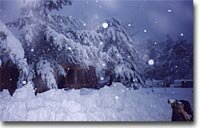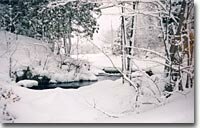Tourist and Traveler Information for Ontario
The Climate of Northern Ontario

Let's say right off the top that we do not have climate in Northern Ontario. We have weather.
Tough, brag about it in your old age weather. Snow storms that last for days and leave snow behind measured in feet instead of inches. Thunderstorms that shake the house. And heat enough in summer to cause you to consider moving farther north!
 Brian J Bird, in his book "The Natural Landscapes of Canada: A Study in Regional Earth Science" published in 1972 says that "Canadians hardly need convincing that their climate is close to glacial. No people on earth have a harder winter to complain about, latitude for latitude. Other nations may have difficulty in visualizing what an ice age means. Canadians have none, because they live not far from reality."
Brian J Bird, in his book "The Natural Landscapes of Canada: A Study in Regional Earth Science" published in 1972 says that "Canadians hardly need convincing that their climate is close to glacial. No people on earth have a harder winter to complain about, latitude for latitude. Other nations may have difficulty in visualizing what an ice age means. Canadians have none, because they live not far from reality."
There are a couple of sound geographical reasons for this. Because of the southern intrusion of the cold waters of Hudson and James bays, Boreal and Southern Arctic environments are found further south in Northern Ontario than anywhere else on earth. The relatively flat Canadian Shield also provides few barriers to weather systems sweeping down from the north. And sweep down they do.
 We've read on a geographical site on the Net that Northern Ontario winters are "extreme enough to be deadly". We don't know about that! (Okay, there are 30-40 deaths a year in this country attributed to cold, so.... maybe.) But then again we take pride in our tough weather and in making it all look easy to live with. What we do agree with is that our weather can be extreme, and at times changeable. Lots of snow in winter is the norm, and very hot and sometimes humid summers are normal too. We do have large temperature ranges. The smallest range is found in , which has a spread of only 28 C� between highest and lowest annual temperatures. At the other end of the scale is Big Trout Lake, which has a 40.5 C� range.
We've read on a geographical site on the Net that Northern Ontario winters are "extreme enough to be deadly". We don't know about that! (Okay, there are 30-40 deaths a year in this country attributed to cold, so.... maybe.) But then again we take pride in our tough weather and in making it all look easy to live with. What we do agree with is that our weather can be extreme, and at times changeable. Lots of snow in winter is the norm, and very hot and sometimes humid summers are normal too. We do have large temperature ranges. The smallest range is found in , which has a spread of only 28 C� between highest and lowest annual temperatures. At the other end of the scale is Big Trout Lake, which has a 40.5 C� range.
Our climate ranges from continental in the southern parts of Northern Ontario to sub artic in the northern areas.

The average maximum temperatures in the City of Greater Sudbury are:



 Brian J Bird, in his book "The Natural Landscapes of Canada: A Study in Regional Earth Science" published in 1972 says that "Canadians hardly need convincing that their climate is close to glacial. No people on earth have a harder winter to complain about, latitude for latitude. Other nations may have difficulty in visualizing what an ice age means. Canadians have none, because they live not far from reality."
Brian J Bird, in his book "The Natural Landscapes of Canada: A Study in Regional Earth Science" published in 1972 says that "Canadians hardly need convincing that their climate is close to glacial. No people on earth have a harder winter to complain about, latitude for latitude. Other nations may have difficulty in visualizing what an ice age means. Canadians have none, because they live not far from reality." We've read on a geographical site on the Net that Northern Ontario winters are "extreme enough to be deadly". We don't know about that! (Okay, there are 30-40 deaths a year in this country attributed to cold, so.... maybe.) But then again we take pride in our tough weather and in making it all look easy to live with. What we do agree with is that our weather can be extreme, and at times changeable. Lots of snow in winter is the norm, and very hot and sometimes humid summers are normal too. We do have large temperature ranges. The smallest range is found in , which has a spread of only 28 C� between highest and lowest annual temperatures. At the other end of the scale is Big Trout Lake, which has a 40.5 C� range.
We've read on a geographical site on the Net that Northern Ontario winters are "extreme enough to be deadly". We don't know about that! (Okay, there are 30-40 deaths a year in this country attributed to cold, so.... maybe.) But then again we take pride in our tough weather and in making it all look easy to live with. What we do agree with is that our weather can be extreme, and at times changeable. Lots of snow in winter is the norm, and very hot and sometimes humid summers are normal too. We do have large temperature ranges. The smallest range is found in , which has a spread of only 28 C� between highest and lowest annual temperatures. At the other end of the scale is Big Trout Lake, which has a 40.5 C� range.